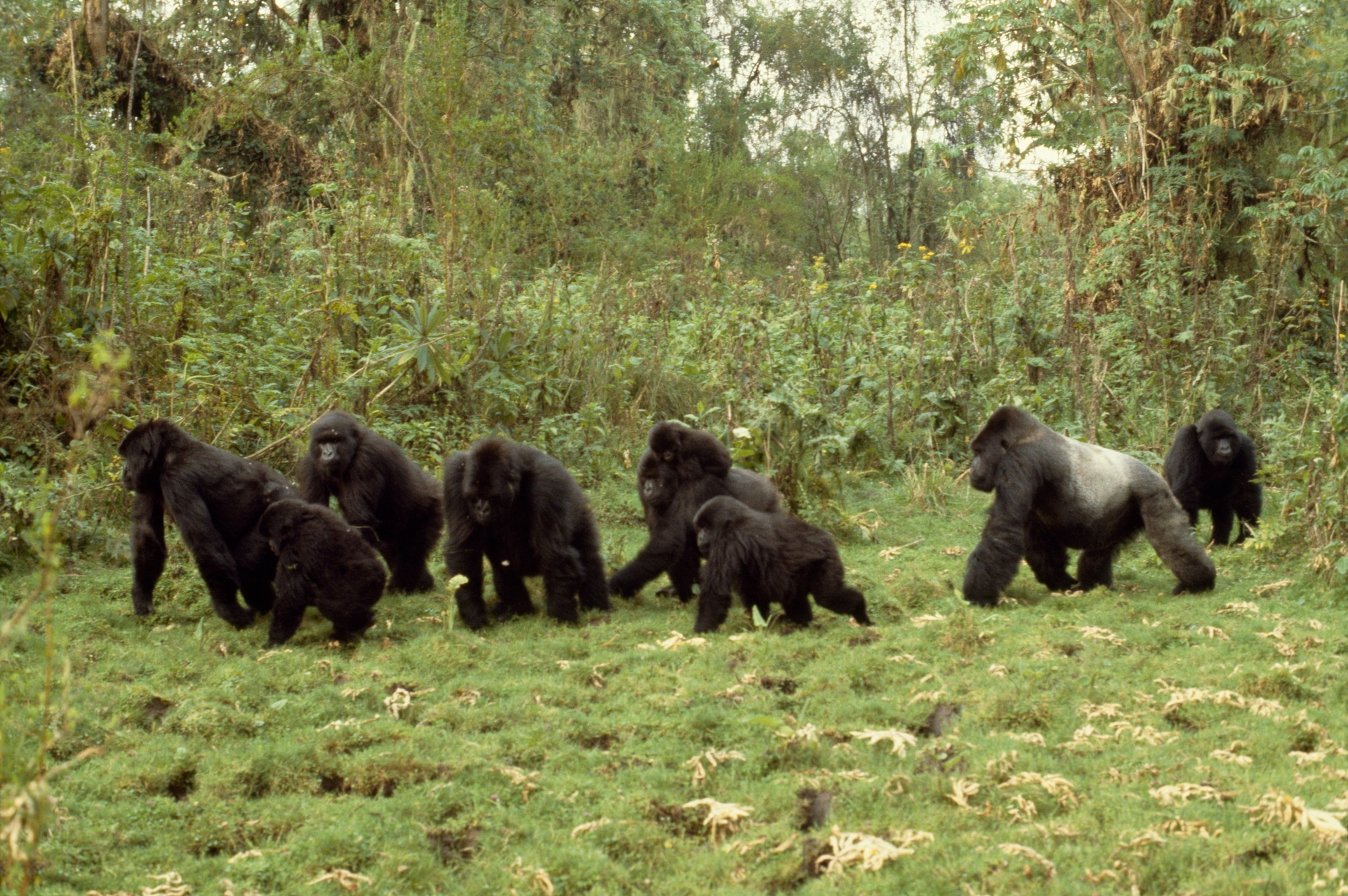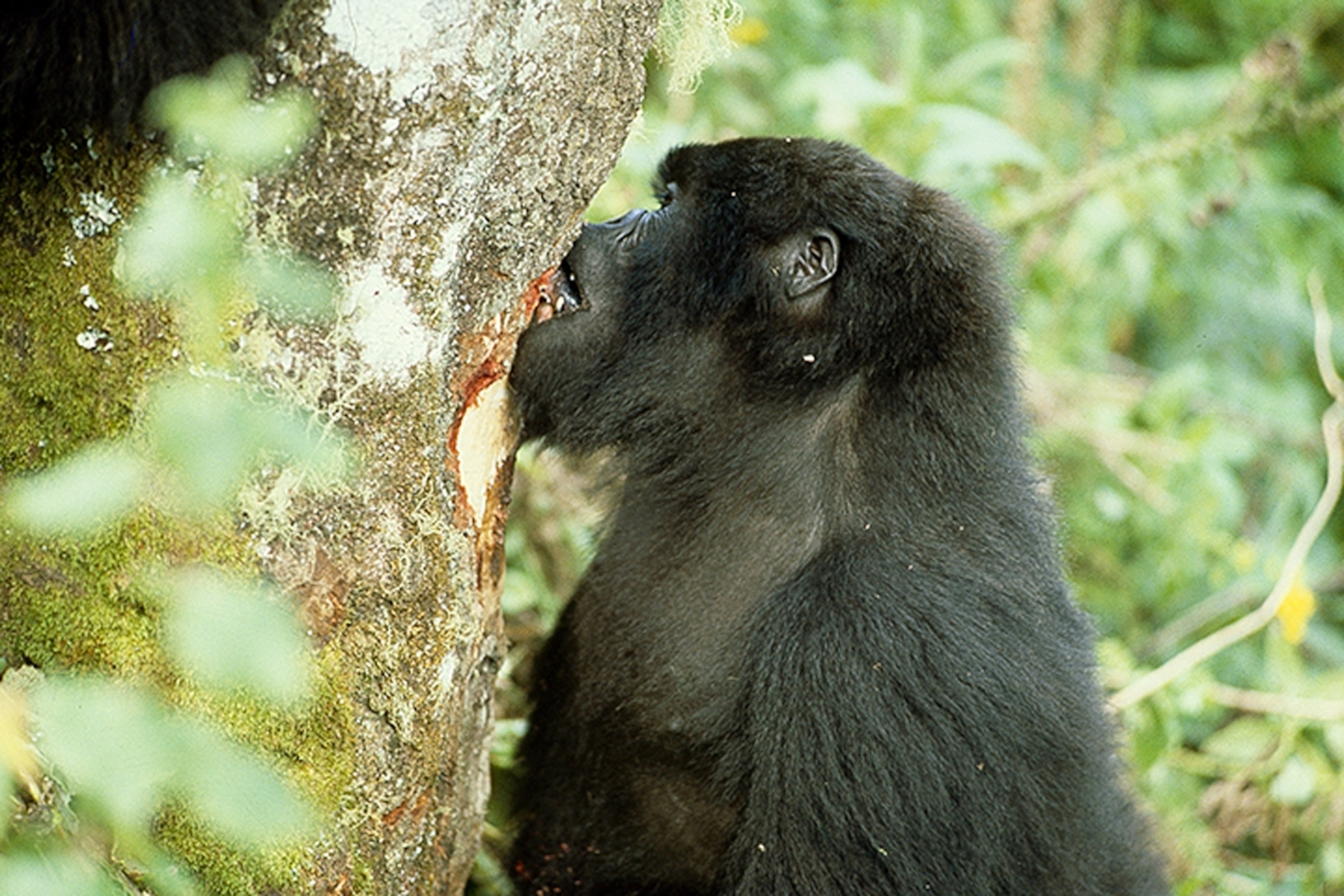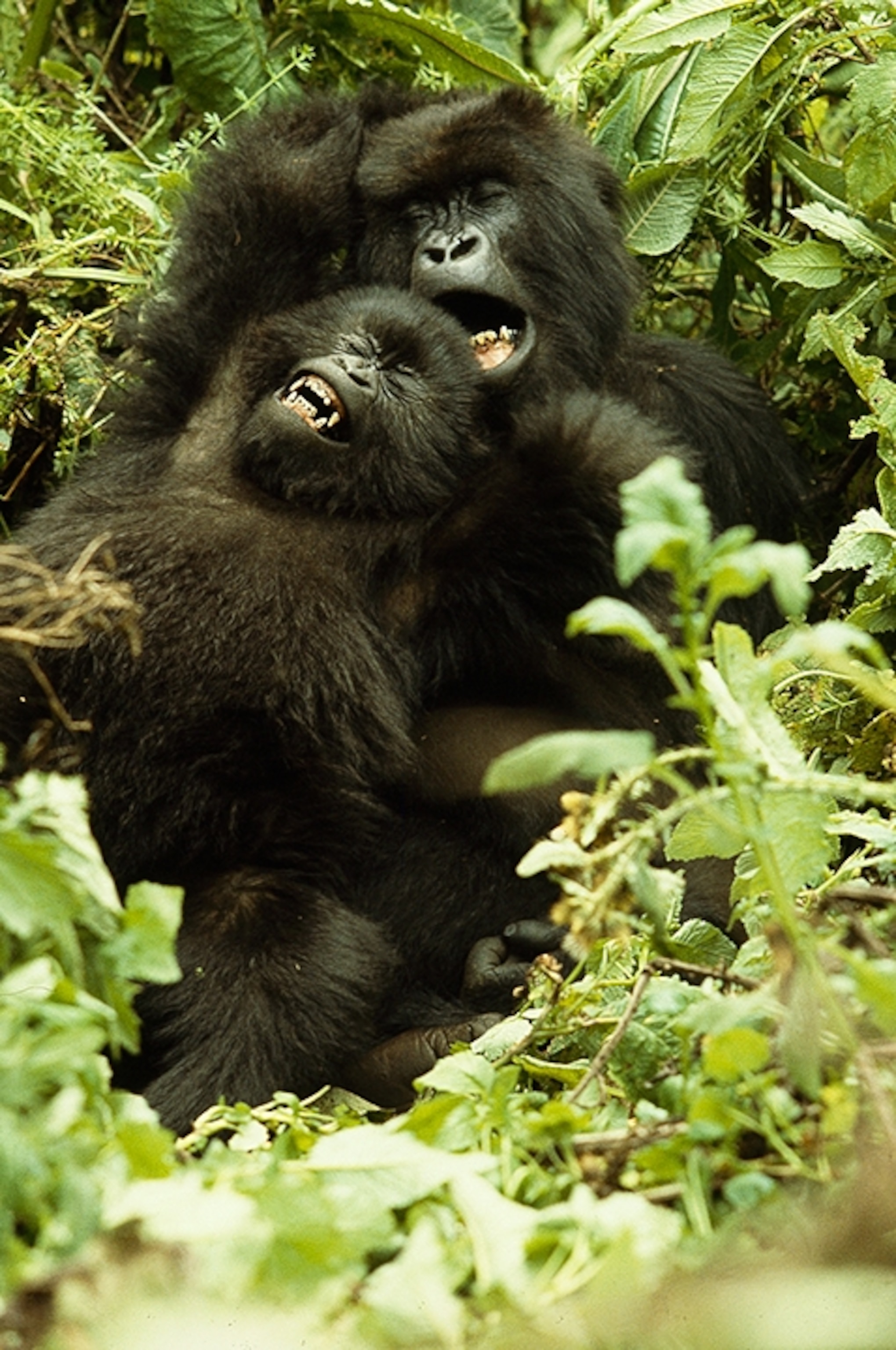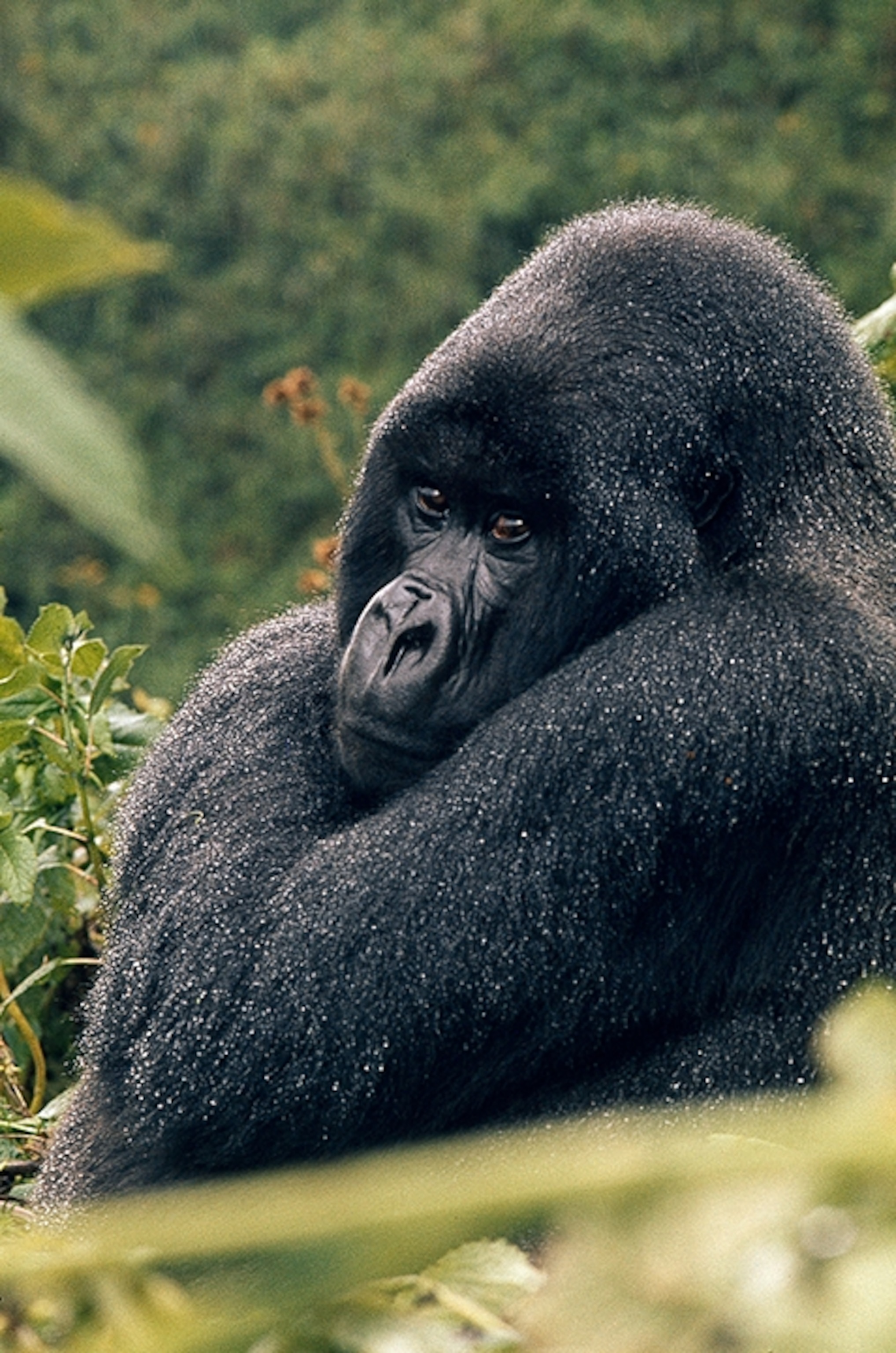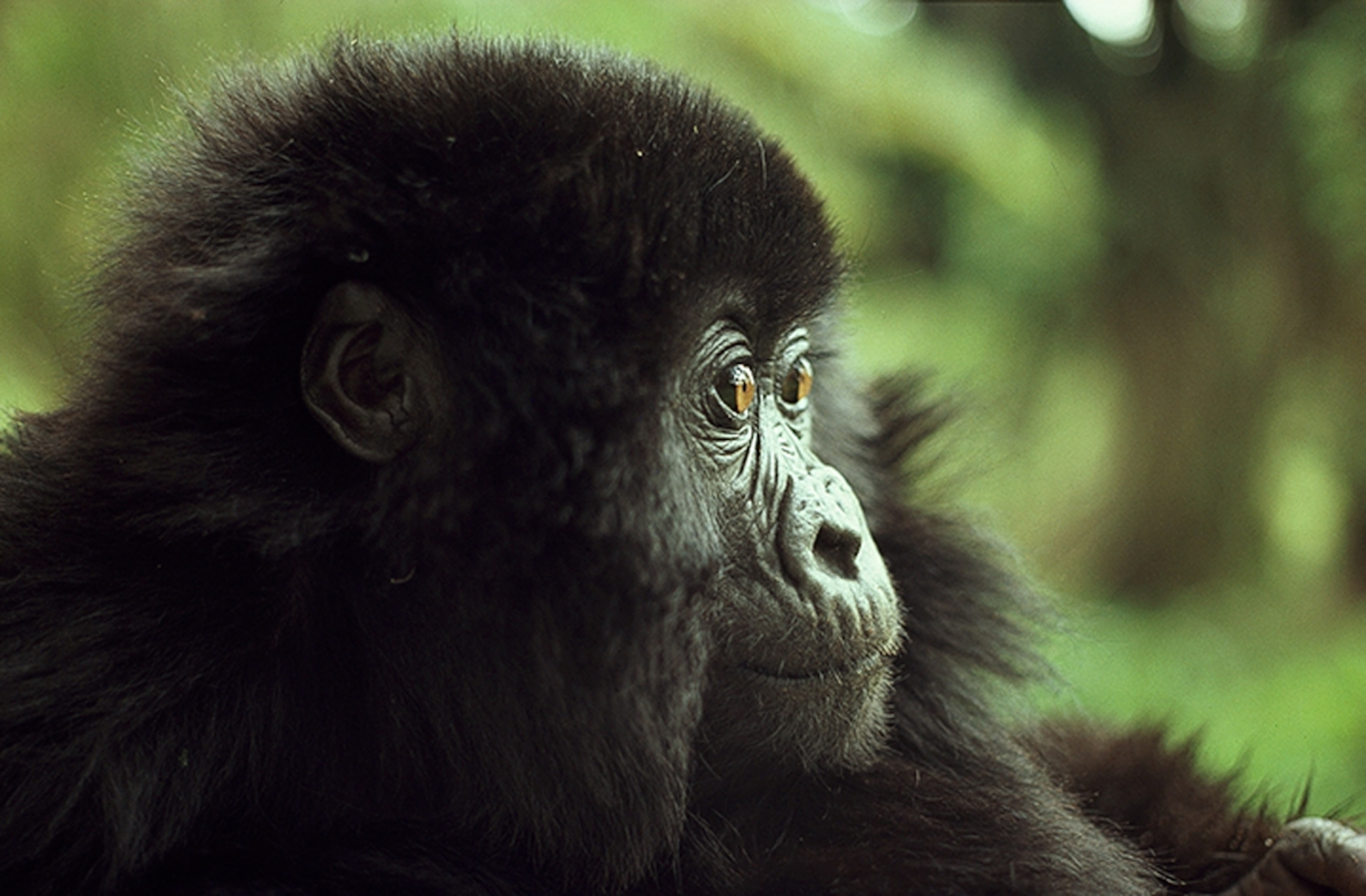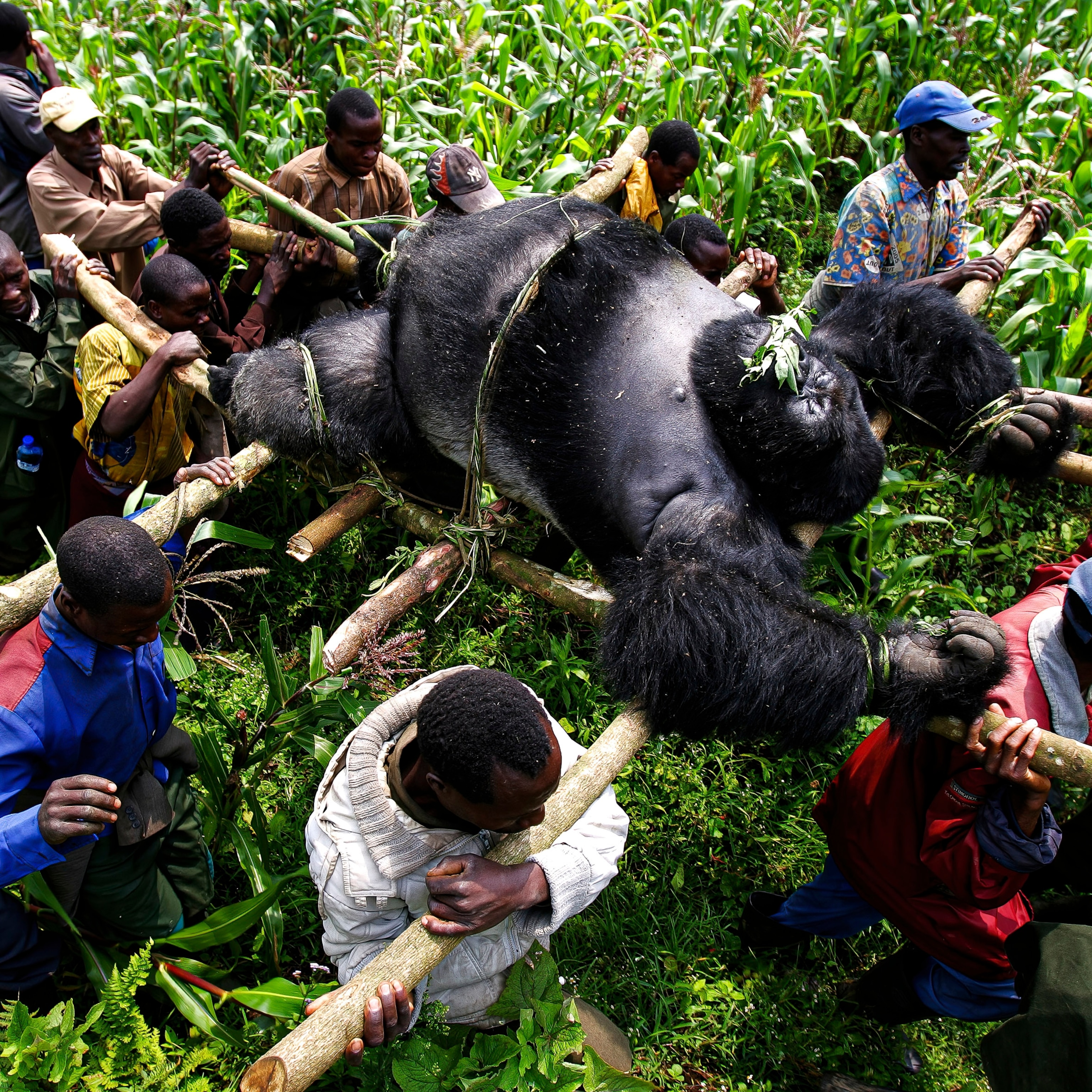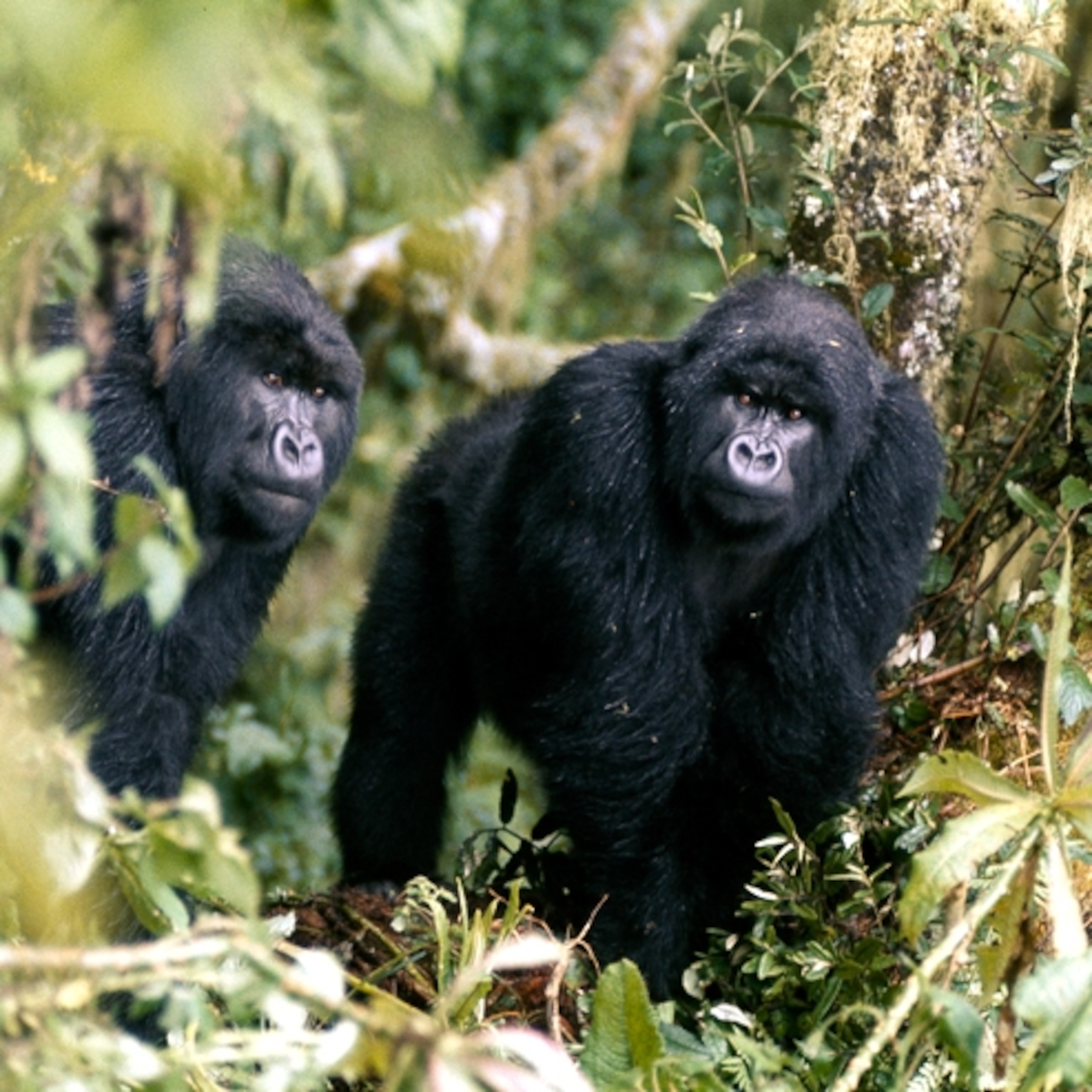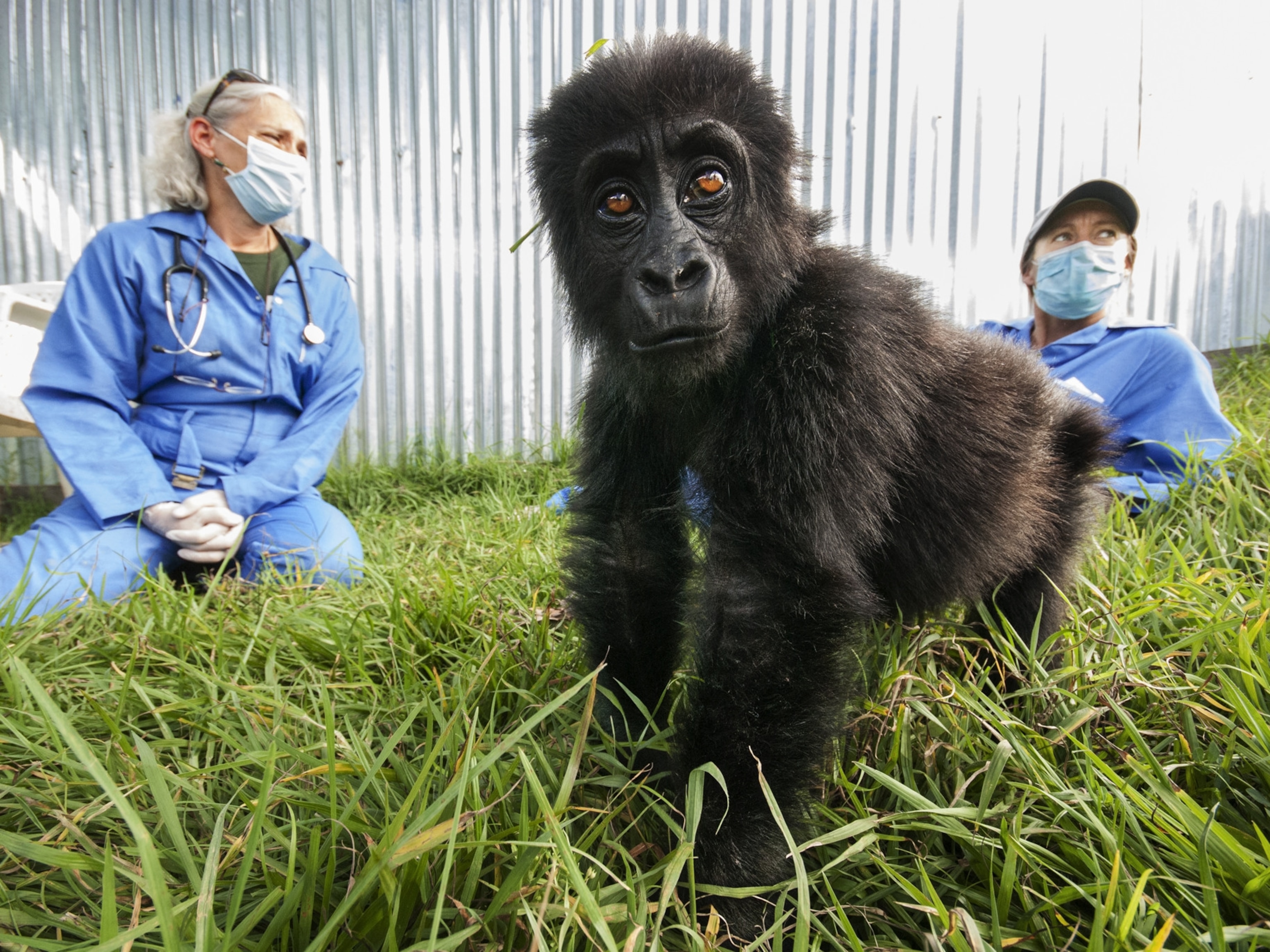The Imperiled Mountain Gorilla: A Grim Struggle for Survival
After a decade of living among Africa’s mountain gorillas, researcher Dian Fossey describes deadly human intrusion and deadly behavior, too, as group leaders struggle for dominance.
It was Digit, and he was gone. The mutilated body, head and hands hacked off for grisly trophies, lay limp in the brush like a bloody sack.
Ian Redmond and a native tracker took the initial shock. They stumbled on the spear-stabbed and mangled body at the end of a line of snares set by antelope poachers. Stunned with grief and horror, Ian composed himself and set out to find me in another part of the forest. An outstanding student helper, he shared my aim to balance research with the goal of saving the imperiled mountain gorillas that I was studying from my base camp in the Virunga Mountains of Rwanda, in central Africa.
For me, this killing was probably the saddest event in all my years of sharing the daily lives of mountain gorillas, now diminished to only about 220 individuals—a reduction by half in just 20 years. Digit was a favorite among the habituated gorillas I was studying: In fact, I was unashamed to call him "my beloved Digit."
And now, through our sorrow, anger welled up—rage against the poachers who had committed this slaughter. Yet poaching is only one of many pressures—human encroachment, land clearing, illicit collecting, tourist presence—that have brought the mountain gorilla to the edge of extinction.
Digit's sad end in 1977 was sheer tragedy, yet in the course of my research, such devastating events have been balanced by many rewarding beginnings in the enlargement of our understanding of these animals.
One fresh start had come late in 1972—the sixth year of my study—when a new "man" entered my life. He was a cantankerous, grizzle-haired silverback, a likable tramp who showed up in the range of Group 5, a gorilla family that lived close to camp.
A student helper rushed in to tell me about the interloper. "I think he's a lone silverback, an older one." (A male gorilla is called a silverback when, at about age 11 to 13, the hair turns gray to silver across his back.)
"Nonsense!" I replied. "Old silverbacks never travel alone. They always stick to their own groups."
I was certain that the animal we came to call Nunkie would turn out to be one of Group 5's younger, peripheral silverbacks, those destined to break away from their home groups to win outside females and start families of their own.
How wrong I was! Nunkie, whom we estimated to be in his mid-30s, was a complete stranger. He didn't match our nose-print sketches (of lined indentations above the nostrils) or photographs of known gorillas.
How Nunkie turned things around—for my research and for the groups I was studying! He opened our eyes to the way gorilla families form and grow. The studies shed new light on previously suspected gorilla behavior, from simple intergroup transfers to the deadly drama of infanticide.
For 13 years I lived with mountain gorillas on the misty slopes of the Virunga volcanoes, which form a section of the borders between Rwanda, Zaire, and Uganda . In a study area of 25 square kilometers around my forest camp 3,000 meters up on Mount Visoke, several groups of these largest of the great apes have become habituated to my presence.
Early in my research, which the National Geographic Society has supported throughout, I discovered that these powerful but shy and gentle animals accepted and responded to my attentions when I acted like a gorilla. So I learned to scratch and groom and beat my chest. I imitated my subjects' vocalizations (hoots, grunts, and belches), munched the foliage they ate, kept low to the ground and deliberate in movement—in short, showed that my curiosity about them matched theirs toward me.
The returns, in new knowledge of gorilla behavior, have exceeded my expectations. I've learned what intelligent and sociable animals these are. Fathers pluck infants from their mothers to groom them, and once I saw an old male tickle a youngster with a long-stemmed flower.
On the negative side, I have had to bury gorilla friends killed and dismembered by poachers, and I've seen how man's encroachment threatens the very survival of Gorilla gorilla beringei, already declared a rare subspecies and existing today only in the Virunga Mountains.
Over the years familial units in my study area, where a succession of students have assisted me as field observers, evolved toward different fates. Nunkie formed an influential new group, one of three dozen we have observed, identified simply by number, and studied. Group 4, under maturing Uncle Bert, suffered decimation that virtually wiped it out. Group 5, led by aged and experienced Beethoven, matched losses with gains and held together as a prime example of group stabilization.
At the outset it is important to know that establishing the genealogy—the family tree, if you will—of each gorilla group was crucial to my study. Transfers between groups, births and deaths, switches in pecking order—these events of population dynamics constantly altered group composition. Understanding the reasons for this fluidity in dramatis personae has been a major goal; however, the shuffling of names and numbers may complicate the picture.
Nunkie, as I have said, gave new perspective on how numbers change within groups, which may range from five to twenty individuals. During his first month in the study area, Nunkie snatched away a young female from Beethoven's Group 5. He dropped her in a few weeks. Over the ensuing months a phantom wanderer, suspected of being Nunkie, seized three more females from Group 5 and was thought to have killed an infant during a violent interaction.
About a year later Nunkie seemed to realize that Uncle Bert, the dominant silverback of Group 4, was inexperienced. He kidnapped two females, Papoose and Petula, from Uncle Bert's family. They have remained with Nunkie to this day. Petula, lowest ranking female in Group 4, had been sexually neglected by Uncle Bert since giving birth to her first offspring, Augustus.
Silverbacks at times neglect subordinate females in favor of the more dominant and senior ones. Petula may, indeed, have been wasting breeding time in Group 4—and if I have learned anything about wild gorillas, it is that they are marvelously controlled by internal, or instinctive, clocks that warn them of interference in natural cycles of reproduction.
Nunkie bred immediately with Petula, and after 11 months she gave birth to the first offspring (a female) that he sired within the Visoke study area. Ten months later Papoose produced Nunkie's second offspring, a male. Building his new family, Nunkie in just eight years has sired six infants among half a dozen females taken from at least three other groups.
We found Nunkie, as his harem and responsibilities grew, spending a lot of time high on Mount Visoke. This was not an area where food was plentiful, but the choicer terrain in the lush saddle between Mounts Visoke and Karisimbi was preempted by established groups—increasingly so as vigilant patrolling curtailed poaching and resistance grew to the human encroachment of land clearing and herdsmen. The higher slopes gave Nunkie's group a fixed, dependable home range, essential for the stabilization of a family group.
Nunkie's phenomenal rise to power gave me once again three main groups habituated to my presence. Two of four groups I had regularly contacted since 1967 had disintegrated by 1978. Of those, Group 9 split up after its dominant silverback died, and Group 8 fell apart because of the death of its aged leader, my specially cherished Rafiki.
Infant Killing May Be Necessary
The collapse of Group 8 threw a spotlight on the grisly practice of infanticide. The matriarch Koko died, and Rafiki with a new mate, Macho, sired a female infant, Thor. Rafiki died before Thor was a year old. The old male left behind a silverback son, Peanuts, who tried to take his father's place safeguarding Macho and his infant half sister. But during an interaction with Group 4, Thor was killed by Uncle Bert.
Though victims usually die almost instantly as the result of one severe and crushing skull bite, accompanied by a deep bite in the lower groin, the initial concept of gorilla killing gorilla was too horrid for me to accept. Yet I now believe infanticide is the means by which a male instinctively seeks to perpetuate his own lineage by killing another male's progeny in order to breed with the victim's mother. In some cases the stratagem seems necessary to maintain a healthy degree of exogamy, or outbreeding. Infanticide has accounted for the deaths of 6 out of 38 infants born over a 13-year period.
Rafiki's mate, Macho, stuck with Peanuts for five months. Then, after fierce interactions between Peanuts and Uncle Bert, dominant silverback of Group 4, Macho joined up with him. Peanuts was cut adrift as the only individual left from decimated Group 8.
As if the fragmentation of Group 8 was not loss enough, the tragedy that soon overwhelmed Group 4 provided a casebook example of group disintegration. With Uncle Bert as leader, and with the help of two younger males, Digit and Tiger, Group 4 accepted another male, Beetsme. This was the first—and so far only—recorded male immigration to a group. Digit, now maturing into a full-fledged silverback impregnated the adult female Simba II. Digit helped Uncle Bert defend the group, and the two silverbacks were amiably compatible. Although the presence of Tiger, more closely related to Uncle Bert, would prevent Digit's ever becoming the dominant silverback, I thought it unlikely that he would abandon Group 4 as long as he was needed.
In the daytime on New Year's Eve 1977, Digit was indeed needed. As watchdog of his natal group, he held off six poachers and their dogs who unexpectedly ran into the gorillas at the end of their trapline set for antelope in the saddle area west of Mount Visoke. Allowing the other 13 members of his group to escape, Digit took five spear wounds, yet in ferocious self-defense managed to kill one of the poachers' dogs before he died for his group.
Uncle Bert led the fleeing group to the safety of Visoke's slopes. The bloodstained poachers were left to celebrate their victory.
After Ian Redmond discovered Digit's mutilated body, we captured one of the killers. He revealed the names of his five accomplices. All but two were imprisoned.
I still mourn Digit. In my first ten years at Visoke, he was the only poacher-killed gorilla from our study groups. Gentle, trusting, loyal Digit, now only a memory in a mound before my cabin. Digit, a father who was never to see his sole offspring, Mwelu.
A few weeks apart, Simba II and Flossie, an older member of Uncle Bert's harem, each gave birth to female infants. The name Mwelu, given to the offspring of Simba II and Digit, is from an African word meaning "a touch of brightness and light."
Following Digit's death, the summer days passed harmoniously for Group 4, the youngsters cavorting in the massive Hagenia trees while the adults snoozed and sunned under bright blue skies. For months now, because of increased patrols, we had seen no signs of poachers.
But the idyll suddenly collapsed in a disaster with permanent repercussions for the already devastated gorilla population. Poachers shot and killed Uncle Bert and his mate Macho. The adults were coming to the defense of their three-year-old son, Kweli, who had been shot through his shoulder in a capture attempt. Led by Tiger, Kweli escaped with the remnants of his group onto Visoke's slopes.
The recapitulation is grim: Over the entire study period, six of the 80 individual gorillas we regularly worked with had been killed by poachers. But evidence in 64 skeletal specimens collected throughout the Virunga Mountains raised the suspicion that poachers were involved in two-thirds of the total deaths.
Apes Threatened by Outside Pressures
The mountain gorilla is legally protected within Rwanda's Parc National des Volcans, where the Karisoke Research Centre is located. In overpopulated Rwanda, however, more agricultural land and meat for food constantly are sought. The park area has been reduced, and pressures relentlessly continue on the reserve and its wildlife.
Money from many sources flows in to help save the gorilla. Unfortunately, manipulation of these funds is all too prevalent. One local official is alleged to have been instructed to kill a gorilla so he could hold it up as an "example" and elicit sympathetic generosity from visiting conservationists.
Tradition and circumstance complicate the poacher's motivation in gorilla killing. Sometimes he inadvertently catches gorilla young in traps set for antelope or buffalo. Other times, bolstering his courage with hashish for a hunt after buffalo or elephant, he meets a gorilla and kills the formidable "foe" for killing's sake. Not infrequently, a poacher is promised money to capture a young gorilla for exhibit in a foreign zoo or for sale as a pet to local Europeans.
One of the gorillas' truest friends, the substitut (sheriff) of Ruhengeri, Paulin Nkubili, ended—with harsh punishment—the practice of selling gorilla skulls, hands, and feet as souvenirs. Mr. Nkubili has impartially punished both black and white violators of protection laws.
After Uncle Bert's death, Group 4 could not, without their silverback leader, continue as a cohesive social unit. Tiger, ready to try the leadership role, nested with the whimpering, newly orphaned Kweli during the agonizing weeks of the injured youngster's decline. Three months after the killing of his parents, Kweli died from bullet-wound complications combined, I think, with acute depression. He was buried between his mother and father, who lay next to Digit. All three adults, in effect, had died so that he might live.
The contest for Group 4 leadership was not over. Tiger didn't have the physique to cope with Beetsme's challenges. At 12 years the oldest silverback (though still a year from sexual maturity) left in the group, Beetsme sought absolute sway over Uncle Bert's dwindling family. We were constant witnesses to Beetsme's aggression: His charges, whacks, biting, and grappling were concentrated against Flossie, and more particularly against her newly born infant, Frito. Could Beetsme have been aware that by killing Uncle Bert's offspring he could return Flossie to estrus and readiness for his own future breeding purposes?
And so the Greek tragedy unfolded: Beetsme managed to kill Frito only 22 days after Uncle Bert's demise. It was Visoke's fourth known infanticide. Two days after Frito's death, Beetsme began copulating with Flossie at her invitation. This was Flossie's way of reducing the antagonistic interactions within the group. But because of youth, inexperience, and lack of blood ties, Beetsme was destined never to become Group 4's leader.
Surviving a Close Shave
We routinely combed the gorillas' favorite feeding places in the saddle between Mounts Visoke and Karisimbi for poachers, and cut animal traps almost as soon as they were set out. One afternoon Ian Redmond and a Rwandan tracker were starting back to camp when they spotted three poachers setting traps with fresh-cut saplings. Quickly, Ian and the tracker dropped out of sight; they intended, after the poachers left, quietly to destroy the poachers' whole line of traps.
Three spear blades suddenly bobbed into view above the knoll where the men were hiding. Ian began to rise to inform the three poachers of his presence. Then, with the instinct of a trapped animal, one poacher dropped his machete. Gripping his spear with both hands, he plunged it downward toward Ian's heart. Ian, totally unarmed, threw up his arm before his chest. (Later he claimed it was a posture picked up from an old kung fu television show.) Undoubtedly the move saved his life, but his left wrist took the full force of the spear thrust. The poacher fled with his comrades.
After binding the wound, Ian and the tracker destroyed the traps before returning to camp. Ian went to Ruhengeri for medical attention, then to England for further treatment. Eventually his wrist mended.
As an outcome of this encounter, I was advised by Rwandan officials to desist from cutting traps, counsel I obeyed reluctantly, especially since gorillas were starting to reoccupy the saddle area.
Through this entire period of violence and readjustment, the benefits of a long-term study became increasingly apparent: It opened up questions and suggested answers about mechanisms of group structure that evolved long before the seemingly extensive, but actually very limited, 13-year period in which I have studied these groups.
The main issue was tantalizing: What part have human interference and the gorillas' own behavioral patterns played in the past to create the particular group compositions in place when I came on the scene? Certainly, our work has documented the startling rate at which social change has been accelerated, even magnified, by man's intrusions on the wild gorilla range.
By the end of 1978, and within the span of a single year, the leaderless Group 4 was destroyed, leaving only young Tiger and Titus, then 11 and 4 1/2 years old, along with the young silverback Beetsme. Surprisingly, they took up company with the lone silverback, Peanuts, who gathered a female and a juvenile from a fringe group to begin a reformation of Group 4.
In fact, within two years after the nadir of its fortunes, Group 4 is—precariously—regenerated, and it is Peanuts who has taken charge as the new unit's silverback leader.
To rebuild itself, Group 4 has needed new blood—which brings me to New Year's Day 1980, when a live but weak young gorilla, confiscated from poachers, was delivered to me in a potato basket. Hoping to sell the illegally captured animal for $1,000, the poachers instead ended up in jail.
During the weeks in which the youngster (later named Bonne Année) was restored to good health, she slept in my cabin and was thoroughly pampered. But I was determined that the waif would be reintroduced to the wild, and I coached her in tree climbing and in selection of forest foods.
Group 4 was the logical choice as a foster family for Bonne Année: Having no infant members and no strong blood ties, Group 4 offered the infant the best chance of acceptance and security.
For myself, time was also a factor prompting immediate action. It was March 1980, and I was overdue to take temporary leave from Africa to assume an academic position at Cornell University.
Bad luck foiled us with Group 4. The day we attempted release, the group fled its usual haunts in a violent interaction with an unknown fringe group. Rendered excitable, possibly hysterical, Group 4 eluded us, and anyway its members would have been in no mood to accept a young stranger.
Next day we offered Bonne Année to Group 5, this being really against my better judgment because of the family's strong blood ties and close-knit mother-infant relationships. With John Fowler, a student, carrying the baby, we climbed into a tree near the resting group.
Beethoven, the reigning silverback, scrutinized Bonne Année intently but made no move toward her. When the young female Tuck and her mother, Effie, moved toward us, Bonne Année slowly left John's arms and climbed down to join her kind.
"The baby wants to be a gorilla," I murmured in relief.
Bonne Année and Tuck briefly embraced. But then Tuck and Effie began fighting for possession of the infant, tugging at her limbs, each dragging her away from the other, both biting her. Bonne Année screamed in pain and terror. Rain started pouring down.
I managed to grab Bonne Année, and passed her up to John. Amazingly, the youngster shortly descended again to Tuck and Effie, determined to be a free-living gorilla. But the two females, joined by the silverback Icarus, resumed their cat-and-mouse torture of Bonne Année.
Dragged by Icarus down the rain-soaked slope and dropped, the battered baby feebly crawled toward our tree and I again passed her up to John, who hid her under his rain jacket. Then Icarus began to climb into the tree! I'll never forget the feeling of Icarus's hot breath penetrating my sodden boots. He stopped, deterred by the sight of two humans, both above him.
For an hour Icarus and Tuck kept us trapped. Finally, the tormentors followed the feeding group out of sight. We fled back to camp with Bonne Année. Her wounds proved not to be serious.
Young Orphan Finds a Home
I had to leave for America with the fate of Bonne Année unresolved. But soon I was overwhelmed with joy to receive a letter telling that our goal had been achieved. Stuart Perimeter, another student at camp, recounted how he and Jean-Pierre von der Becke, a Belgian park adviser, had led Bonne Année to the area where Group 4 was feeding. Jean-Pierre had marked Bonne Année with dung from the group, so that human odors on the infant would be overridden by familiar gorilla scents.
To the limb of a fallen tree, Stuart secured a feeding sack he had devised: Fruit placed inside the burlap bag could only be retrieved by the infant's thrusting her head into a hole cut near the top.
Bonne Année stuck her head into the bag and started eating the chunks of pineapple and banana. Stuart and Jean-Pierre moved out of sight, Bonne Année whimpered once (no doubt on finishing the fruit and finding herself alone), and all the members of Group 4 moved toward the infant.
An hour later Stuart and Jean-Pierre returned to find Bonne Année playing with Titus, until then the youngest member of the group. Three feet away, the silverback Peanuts presided over the goings-on.
When Bonne Année saw her human friends and moved downslope in their direction, Peanuts blocked her path, threatening, as if to say, "This infant belongs to Group 4 now!"
And so success crowned the very first effort ever to reintroduce a captive gorilla to the wild.
Beethoven Key to Group's Harmony
In contrast to the near destruction of Group 4, Group 5 has been a heartening example of a well-stabilized family unit. To maintain a group's durability over time requires a strong silverback, support from a maturing male, and enough females to allow regular breeding opportunities.
Over 13 years, under the steady leadership of the old silverback Beethoven, 32 different gorillas have been part of Group 5. Five of the 13 present members belonged to the group as I first knew it in 1967.
Notwithstanding gains and losses from births, deaths, transfers, silverback breakaways, and one disappearance, the group never required female immigrants for expansion, a testament to group stability.
Aging Beethoven, after leading his group for an estimated 40 years, had a vigorous backup in his silverback son, Icarus. From the occasional violence with other groups, Beethoven often emerged badly wounded. He fell into the habit of avoiding trouble, or of outright flight. But feisty Icarus, always gung ho to pit his strength against all challengers, drew attention to Group 5 with his prolonged hoots and chest beats.
Relations between father and son stayed harmonious until, around his 12th year, Icarus attained sexual maturity. Reaching this stage, subordinate males such as Icarus have never been observed trying to mate with older females; these "belong" to the dominant silverback. But as Beethoven weakened, antagonism intensified between the two males on the days each month the senior females were in estrus. Harsh and agitated vocalizations, much like pig grunts, along with charging, created a great deal of friction within the group.
Year by year Icarus faced an escalating problem. If he survived, he unquestionably would succeed to the leadership of Group 5 upon Beethoven's death. He was therefore unlikely to leave it. Nevertheless, in his first three years of sexual maturity, Icarus would have access to only one or two adult females and sire but two offspring among the younger adult females. His father, Beethoven, over the past 13 years has been master of a ten-female harem that has given him 20 youngsters, ten of which survive.
How many more years Icarus would have to accept this limited reproductive role would hang on how much longer Beethoven lived and on the fate of the females that he, Beethoven, was able to keep for himself. I was sure that Beethoven wouldn't relinquish to Icarus mating privileges with the two oldest females, Effie and Marchessa.
So until an unexpected—and shattering—event upset this balance, Icarus for his breeding success had to count on the group's three younger females or the acquisition of mates from other groups.
At the age of 9 1/2 years, Pantsy, Beethoven's oldest daughter within the group, gave birth to an infant, Banjo, that Beethoven had sired. At six months, Banjo disappeared: I believe the baby was killed, and—on the basis of bone splinters collected from dung—I think it may have been partially eaten by other members of its family.
Pantsy almost at once started mating with Icarus. A year later Pantsy gave birth to Icarus's first offspring, daughter Muraha. I named Muraha for a new volcano that erupted across the border in Zaire. The volcano soon fizzled out, but not Muraha! From the day of her birth she was exceptional in vitality, development, dexterity, and alertness. Her bright eyes seemed to say, "Look out, world. Here I come!"
Surviving ups and downs, Group 5 moved about contentedly, subtly divided into two mini-groups, Effie and her brood of four and Marchessa with her three. Such clusterings help lessen friction within a gorilla familial unit.
Effie and her younger offspring—Puck, Tuck, and Poppy—were a devoted quartet. Puck, at eight years an adult, earlier had shown immense curiosity about us as ever present observers, and about the strange equipment we carried. Photographers became human octopuses trying to guard their lenses, film cartridges, tripods, batteries, and light meters from Puck's persistent inquisitiveness.
The young gorilla would adapt long lenses for use as telescopes or microscopes. Many of our contacts ended like Easter egg hunts, as I sought to retrieve purloined photographic gear.
Notable for boldness as well as curiosity, Puck had always been "known" to be a male. We often saw the animal engaged in play mountings of female and immature gorillas. The young adult's canines grew like those of a male, and the hair on the back of its head was slightly silvered.
But at the age of ten, the blackback Puck gave birth to a male infant! The newborn "impossibility" won the name Cantsbee, from my first shocked words when I heard the news.
Family Hierarchy Provoked Tragedy
The Icarus-Beethoven relationship now has taken a new turn. Just eight months ago came tragic news: the killing of Beethoven's long-term mate Marchessa. It is sad to us but understandable—perhaps even inevitable—in terms of the inflexible rules of gorilla familial hierarchy.
Students Peter G. Veit and John Fowler, who maintained the Karisoke Research Centre after I left, wrote to me in the United States about Marchessa's death and Icarus's role in it. Peter has described the event. However troubling and puzzling, it surely underscores the power of gorilla kinship ties.
Yet, what was Icarus's cognizance of his actions? In assuring the death of Marchessa, I believe that Icarus responded to the instinct to protect his own genes—to guarantee that aging Beethoven would not breed again with Marchessa.
Now Icarus commands the entire group, and can mate at will with any female other than his mother, Effie—there an innate taboo exists.
Though it can be exceedingly arduous, long-term research such as ours at the Karisoke Research Centre carries with it great rewards—in discoveries and in correcting mistakes stumbled into through false assumptions. The births of Cantsbee and, more recently, of Effie's latest, Maggie, help replenish the population of surviving mountain gorillas. Perhaps we will find—we may hope, at least—that the gorillas' own strategies of group growth and maintenance will circumvent group disintegration caused by man's encroachment.


